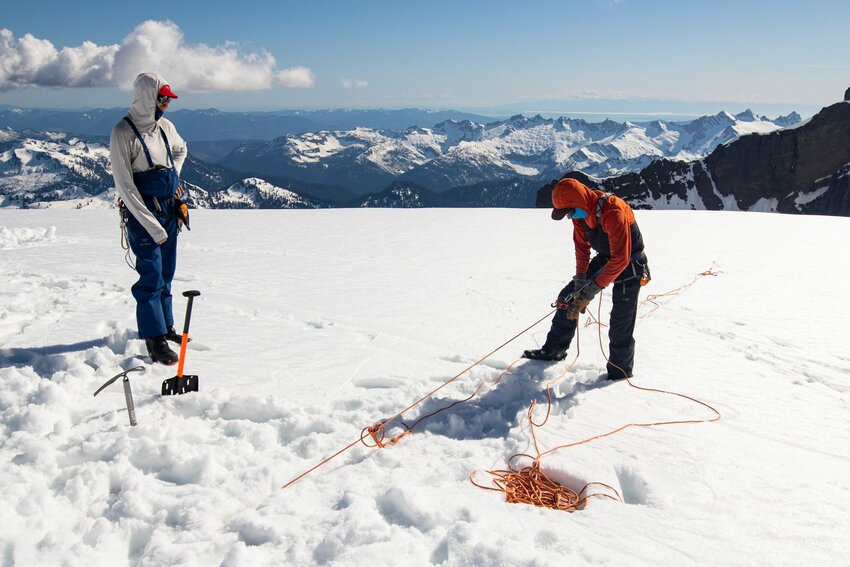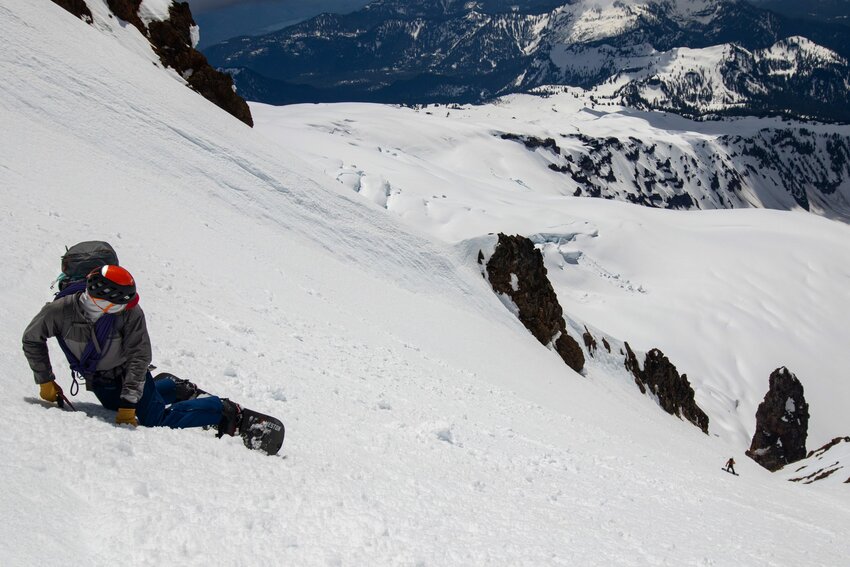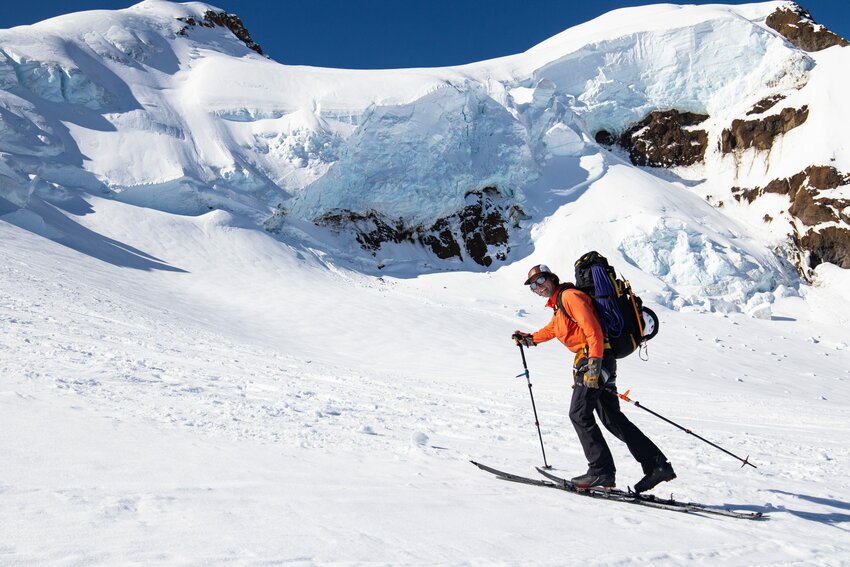
It’s breaking blue over the shark’s fin of Shuksan, a cloud ripper of a summit pyramid that can often be seen cruising the low tide fogs that swirl about the range. Halfway through a high orbit of the peak is Jere Burrell, taking the helm and keeping this ship on a steadfast course.
Behind him are the rest of his American Mountain Guide Association (AMGA) ski guide exam cohort, a cadre of sharply honed individuals who have been training for this day for years and can each turn a ski like it’s a brush across a canvas. He’s leading the team on one of their final objectives to test their skills as potential AMGA-certified ski guides, navigating the transition from the Sulphide to the Crystal glacier when an awkward impasse presents itself: A drawn out and low angle traverse.
Normally not a problem, but like so many times before, Burrell finds himself odd man out. Everyone around him has two planks strapped to their feet. He has one. Positioning himself a few meters upslope of the rest of the crew and calculating his fall line, Burrell leads off cross slope and pulls it off without a hitch, and no one else seems to notice.
For Jere, that’s the point. As a splitboarder, he’s often under a higher power microscope to perform when it comes to mixed company, and more so when he’s being paid to be the professional in the room. It’s not an unfamiliar situation for Burrell. Every job he’s guided, he’s also been the only splitbboarder on staff.
Now, as only the 10th AMGA-certified ski guide to have done so on a splitboard, it’s a career path that he has navigated without much in the way of mentors. Burrell has, in large part, kicked in the skintrack on his own.
 To many yet in the ski guide industry, skis are simply the superior tool for backcountry guiding. They are believed to tour better, are more easily willed into adhesion on the slippery surface of rain crust skin tracks, shuffled and side-stepped up awkward humps, quicker to flip the switch from up to down and back again. They are seen to be in many ways more efficient, assuredly making them the tool for the job.
To many yet in the ski guide industry, skis are simply the superior tool for backcountry guiding. They are believed to tour better, are more easily willed into adhesion on the slippery surface of rain crust skin tracks, shuffled and side-stepped up awkward humps, quicker to flip the switch from up to down and back again. They are seen to be in many ways more efficient, assuredly making them the tool for the job.
And that, coupled with still lingering ski resort rivalries, has meant that while ski guiding has enjoyed a long and storied history, splitboard guiding has struggled in the margins. But as an explosion of new backcountry users has surged across the country, the need for splitboard guides is only growing, which has many rethinking what splitboarders can really do.
But ask the man who built himself up scraping for whatever tool he could find kicking around the toolbox. He’d probably tell you that if all you have is a hammer, everything damn well probably looks like a nail. He’d say there’s more than one way to skin this slope.
When Burrell began dipping his toes into the backcountry, splitboards were still firmly seated in the realm of garage science. Where anyone with enough gumption or at least a six pack could take a circular saw to their snowboard and turn it into two, ending up with a machine that goes both up and down hills, but did neither exceptionally well. Thus, his first forays into the backcountry were by way of the exposed rocky ridges of Colorado, strapping snowshoes on his feet and his board on his back to pseudo-guide friends into the hills.
“Snowshoeing was arduous. In order to get my friends to come where I wanted to go, I would spend days putting in a snowshoe track. Go up one day, go as far as I could, come down, go back up the next day, put it further up the mountain, and then I could say: ‘The track is in, let’s go,’” Burrell says. “To me it was worth it.”
But as his 30th year came, and Burrell by then resolutely certain of his desire to become a snowboard guide, so came the 161-centimeter Venture Storm splitboard. He had the budding proficiency, but now he had the efficiency. Soon after came a move to the snowboarding center of the universe that is Mt. Baker, as well as enrollment in AMGA courses, which, while not required in the U.S. to become a mountain guide, are an excellent way to become a highly-capable mountain leader.
 The occupation of splitboard guide likely winked into existence in the early 2000s, when splitboard pioneer and Burton designer Dave Downing put a board into the hands of snowboarding icon and Mt. Baker local Craig Kelly. Kelly had recently turned his back to the international contests and video parts that had made his name famous and faced fully into the mountains, beginning to guide as a snowboarder for British Columbia’s Baldface Lodge in 2001. That same year Kelly began training to become certified as a Canadian Mountain Guide, but tragically lost his life in an avalanche in 2003.
The occupation of splitboard guide likely winked into existence in the early 2000s, when splitboard pioneer and Burton designer Dave Downing put a board into the hands of snowboarding icon and Mt. Baker local Craig Kelly. Kelly had recently turned his back to the international contests and video parts that had made his name famous and faced fully into the mountains, beginning to guide as a snowboarder for British Columbia’s Baldface Lodge in 2001. That same year Kelly began training to become certified as a Canadian Mountain Guide, but tragically lost his life in an avalanche in 2003.
Burrell sees the history of splitboard guiding as disjointed, like an engine sputtering to start. While many across the country were making their own way, they existed in their own bubbles, lacking mentors or ability to follow anyone who had blazed the path before them.
“I remember thinking. I don’t know how to do this, and I don’t know anybody that does, but I’ve got to figure this out. We’re just writing the story now, that’s what it felt like,” Burrell says. “There’s no book here.”
For many years, the AMGA did not accept splitboards to be used to receive full ski guide certification, which led some snowboarders to pivot to skiing in order to begin guiding. Then, in 2014 the AMGA announced that they would allow splitboards, opening a door of legitimacy to many who had previously been given the choice: Learn to ski, or learn to make a living doing something else. The following year saw its first two splitboard guides pass the exam: Brendan Burns and Eric Layton, with a handful of others in the years following.
 While Burrell was working through his AMGA courses he began work as a guide for Baker Mountain Guides, where on one of his first tours with clients he received what likely must have felt like a snowboarding Oscar: “Dude, you’re like one of the most organized splitboarders I’ve ever seen.”
While Burrell was working through his AMGA courses he began work as a guide for Baker Mountain Guides, where on one of his first tours with clients he received what likely must have felt like a snowboarding Oscar: “Dude, you’re like one of the most organized splitboarders I’ve ever seen.”
“You leave them with that impression, and they don’t have to question if you’re skiing or snowboarding,” Burrell says. “The tool is different, but this person has it together.”
Being absolutely dialed in every other aspect assuaged any doubt in his clients’ mind, letting his riding and guiding speak for him. Burrell put in two winters under the Baker Mountain Guides banner, then pivoted to North Bend’s Pro Guiding Service, where he enjoyed the role of “the dude” when it came to splitboarding and was handed the keys to create all of the splitboard course programming for the outfit. It was also around this time when Burrell says he began to feel that the pressure was really on to eke out every last efficiency in his systems.
Jason Speer knows this dilemma all too well. Speer, an avalanche course instructor and splitboard guide for the American Alpine Institute, is also aiming for his AMGA Ski Guide certification, but certainly doesn’t have his wires crossed when it comes to what tool he’ll be completing his exam on.
“Skis are very practical, and that’s part of the reason snowboarding is better. Skiing, if you go back to the beginning, was about being practical travel from A to B in the mountains. There’s always going to be some portion of it that’s about practical travel,” Speer says. “Snowboarding was never bothered with being practical. It didn’t have to get you from A to B, it had to be fun.”
Essentially, nobody commutes on a surfboard.
The lineage of board sports simply aren’t cut from the same transportation cloth that saw skis of wood and horsehair traversing the rough taiga, and splitboarding has long dealt with a single weak point in the soft boots that many bring over from snowboarding. While exceptional for the way down, soft boots while climbing are just that: soft, providing poor power transfer while on edge. Something with a bit more backbone is needed for truly easy backcountry touring, and new technology is getting us damn near close. Well, not exactly new.
As sure as there’s nothing novel under the sun, ski boots (or, as splitters like to call them, hardboots) are finding their way back onto snowboarders feet. The early years saw intrepid splitboarders who were pushing further into the mountains grabbing off the shelf touring boots and having at them with whatever sharp implement they could get their mitts on, often drilling holes and cutting slits in the plastic cuffs in an attempt to loosen up the lateral flex. These Frankenboots have now given way to the first commercial hardboot for splitboarders, the Phantom Slipper, which brings with it, a newfound touring ability that brings splitboards directly on par with their ski pals.
 “As soon as I put them on, I knew this was easier,” Burrell says. “Your stride length is longer, the effort that you use is less, the range of motion in your kick turns is much bigger, the pivot of your toe is much larger. Everything that contributes to energy efficiency is there.” It’s unsurprising that many of those who aim to push higher and further into the mountains on splitboards are making the switch, guide or not.
“As soon as I put them on, I knew this was easier,” Burrell says. “Your stride length is longer, the effort that you use is less, the range of motion in your kick turns is much bigger, the pivot of your toe is much larger. Everything that contributes to energy efficiency is there.” It’s unsurprising that many of those who aim to push higher and further into the mountains on splitboards are making the switch, guide or not.
Following Burrell’s completion of his ski guide exam in spring 2021 he was certified as an AMGA Ski Guide, putting him in rare company. In a parking lot conversation last season, Burrell and Speer attempted to tally up the number of splitboard guides in the state, AMGA-certified or not, and failed to employ a second hand.
Burrell has now completed season one of his own guide service, Guided Exposure, where he successfully took out a slate of skiers and splitboarders into the hills last winter, and now considers it part of his trajectory to create more splitboard guides. Though the industry as a whole has been slow to adopt the occupation, the need has never been greater, and while accumulating more pins and badges than an Eagle Scout isn’t very punk rock, splitboard guiding is still in a way riding that counterculture wave that spurred snowboarding in the first place.
It’s backcountry touring, on their terms. x
Based in Bellingham, Nick Belcaster is an adventure journalist who enjoys breaking tree line, carrying as little as necessary and long walks across the country.